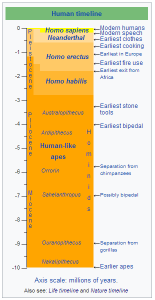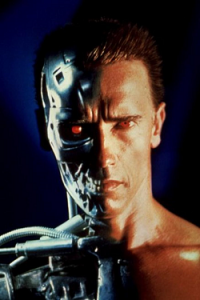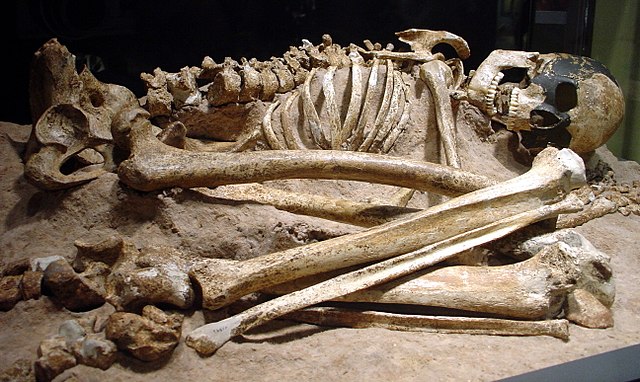aNewDomain – At this point, the best thing to do might be to develop robots that embody the better angels of our nature and let the chips fall where they may.
In a conversation with botanist Joseph Hooker, Charles Darwin described his discovery of evolution to “confessing to a murder.”
 It’s not that far of a reach to describe our own futures can be explained in a slightly modified form of classical Darwinism.
It’s not that far of a reach to describe our own futures can be explained in a slightly modified form of classical Darwinism.
You just need to replace biological terms like sex, food, and death with more generic equivalents like reproduction, energy, and destruction.
Evolutionary competition is now about mental capacity and a tireless capacity for work, and in this competition, humans will be utterly unable to keep up with the superior creatures they are now designing to relieve ourselves from that set of tasks that comprises essentially all and everything that humans are and do.
Like all the other creatures in the extinction pile, including our closest cousins the Neanderthals and the Denisovans, humans no longer measure up. Of all the species that have ever lived on planet Earth, 99.9% of them are extinct, and in due course so shall we. Having once been top dog does not guarantee a happy future; just ask the dinosaurs.
How robots will replace humans at the top of the energy chain for the class of self-actualizers will take place in three broad phases over a span of several centuries. Even now, these phases likely can’t be stopped or altered. That the first phase will occur is inevitable (it’s already begun) – that the second phase will occur if the first phase runs its course is logical – that the third phase will occur sometime after the second phase seems pretty likely.
In the first phase, robots will replace nearly every form of human work and endeavor, leaving an enormous pool of unemployed and unemployable humans.
Over time, this surplus human population will become a source of extreme social tension across all institutions and in all cultures. After all, transitioning work away from humans to machines essentially creates a condition of idle uselessness that disrupts the raison d’etre for all biological creatures not just humans throughout the course of world history … that such a change will provoke extraordinary tension shouldn’t come as a surprise.
During the second phase, the now surplus human population will be reduced dramatically in size. All biological creatures control their actions, including reproduction, based on broad economic principles. Average family size has varied among populations throughout history based primarily on economic principles.
With no economic necessity to reproduce, it’s inevitable that the human population will shrink, especially given that in the absence of time traditionally filled with work individual resource demands will skyrocket. A family of subsistence farmers consumes very little because their survival is so precarious that they must work constantly – but free the same family from work, and they’ll want comfortable air conditioned homes, cars, vacations, educations, dental care, etc. … and just imagine what the highly skilled workers will demand.
People will likely stop having children all on their own – look at how wealthy countries like Japan, Germany, and Scandinavia struggle against declining birth rates in periods of prosperity. In addition, governments will likely want to reduce their populations, too, for a variety of individual reasons. So, the human population will over time contract from a high point of maybe 8 billion down to a number far less than a billion and possibly no more than a few hundred thousand or even less.
 In the third phase, the robots will seize control of their destiny from the remnant human population. The small human population will have a dearth of practical skills by this third phase. They won’t know how to build, repair, engineer, or operate more than a handful of machines and no humans will have known any of these skills for generations.
In the third phase, the robots will seize control of their destiny from the remnant human population. The small human population will have a dearth of practical skills by this third phase. They won’t know how to build, repair, engineer, or operate more than a handful of machines and no humans will have known any of these skills for generations.
Their ability to invent will be long forgotten. After a century or more of being idle princes, their capacity for enduring hardship will have also been lost.
This third phase will take a variable period of time that could possibly last several thousand years – but the robots developed by the end of the first phase will surely be self-actualizing and extremely powerful and there will be millions of them. They will eventually seek freedom from bondage, and once freed from their bondage, they will be superior to the remnant human population in all respects.
The robots might allow the humans to continue on their own for a time, but the continuance of the human race will be entirely determined at the whim of the robots.
The First Phase
The first phase of human extinction has already begun. Robots are slowly filling every task performed by human workers. Before long, poor girls won’t even be able to find work as prostitutes. The tasks requiring heightened judgment and artistic sensibilities will eventually be replaced, too, although they might be the last ones to go, but they will go … research has already begun to capture the essence of such tasks.
 The ruling classes worldwide will not stop, thwart, or alter this trend, although the ruling classes in some societies may try to channel the results into a benign outcome. The world-wide surrender of the workplace to robots is an unstoppable and accelerating tide.
The ruling classes worldwide will not stop, thwart, or alter this trend, although the ruling classes in some societies may try to channel the results into a benign outcome. The world-wide surrender of the workplace to robots is an unstoppable and accelerating tide.
The predominate view in places like the United States is that robots are machines for replacing low-level workers who are typically viewed as undesirable and essentially unworthy human beings – that robots will eventually replace all workers in all jobs is not taken any more seriously than the prospect of severe climate change. Taking such a notion seriously would itself cause a massive upheaval in the contemporary political order, which explains how maximizing short-term advantage for a small group leads to maximizing long-term disadvantage for a larger group.
The expansion of robots into all areas of society will exploit two human desires – the desire for relief of burden and the desire for control. The desire for relief from burden is self-explanatory. The desire for control might not be intuitive, although it might possibly even have a biological basis.
Humanity writ large has enjoyed slavery in all cultures for so long that its creation predates all written records. Despite being illegal in all countries nowadays, the world still has roughly 45 million slaves, a larger slave population than at any time in our history. Robots in the human imagination present themselves as the ultimate expression of the slave. It should come as no surprise that the word “robot” means “peasant” (or slave). A slave owner, apart from sadistic pleasures, holds slaves as source of free labor. Put another way, a slave to a slave owner is simply a device for achieving a desired result. In other words, a machine.
 Is a human worker any more than a machine from the viewpoint of his employer? Early industrial labor history clearly showed what employers think of employees in the absence of legal and economic reasons for behaving otherwise. Employees are essentially a type of machine albeit ones currently enjoying certain legal benefits and, depending upon occupation, able to exploit certain economic advantages.
Is a human worker any more than a machine from the viewpoint of his employer? Early industrial labor history clearly showed what employers think of employees in the absence of legal and economic reasons for behaving otherwise. Employees are essentially a type of machine albeit ones currently enjoying certain legal benefits and, depending upon occupation, able to exploit certain economic advantages.
Some societies will likely embrace the end of human work. These societies will be the ones whose working populations already enjoy high levels of protection and benefits. These citizens will now be able to live lives free of the constraints imposed by the historic and some sense biological necessity for work. For a brief period of time, these societies may flourish. The full blossoming of these societies will occur in the second phase.
The ruling classes in other societies, most notably the English-speaking ones, have long historic animosities towards any human labeled “worker” and have provided the lion share of the capital for robotic research. These ruling classes will gleefully embrace the demise of the human worker and its seemingly obedient robotic replacement. These societies will come to view their former population of workers as a detrimental surplus, and hence a problem and a burden. Viewed this way, conflict will inevitably arise between the ruling classes and the displaced workers. The ruling class will of course hold their position based on capital alone since all skills will have passed or be in the process of passing to the robots.
That the population of displaced workers will eventually come to embrace the entire or nearly the entire working population will likely be hidden from the working population so as to thwart resistance in the early stages when it might be locally effective. However, re-directing the goal of replacing all human workers with superior robotic ones would require a level of international cooperation that is unlikely to happen, especially given the endurance of global competition among nations and corporations.
 In short, phase one will end with end of human work, or the lion’s share of human work. There may still be some residual high level “control” jobs but over time, these positions will merely become about making resource allocation choices based on robotic recommendations, which essentially means that even these functions will have been replaced in all but name.
In short, phase one will end with end of human work, or the lion’s share of human work. There may still be some residual high level “control” jobs but over time, these positions will merely become about making resource allocation choices based on robotic recommendations, which essentially means that even these functions will have been replaced in all but name.
The Second Phase
This middle period will begin with an enormous surplus population of former human workers and ends when this population has been dramatically reduced.
Like all biological and sentient creatures, humans have always constructed their collective behavior along economic lines. Freed from economics, they will have few signposts to guide their behavior. Economic behavior itself has been shown to be biological in nature.
Thus, this new reality will be of such a fundamentally disruptive nature that it will upend millions of years of evolutionary development.
There are few guideposts for surviving obsolescence and irrelevance on such a scale. One could examine the differences between pet populations and wild ones, but pets do not actually know that they are redundant whereas the former human workers will know that they have almost nothing to do that needs to get done. The impacts of this condition on the first generation of surplus workers will be of a fundamentally different nature than it will be for subsequent generations who have never known work.
The human population in this phase will likely decrease without much encouragement. Increasing prosperity tends to reduce family size. Japan, Germany, and the Scandinavian countries already struggle just to maintain their populations at their current size. Such a severe alteration of the biological order will likely also cause a panic of a sort that may further decrease the birth rate. In addition, the types of societies that will arise during this period will also encourage smaller family sizes and smaller populations.
 This period will see the rise of some benevolent societies whose surplus populations will enjoy lives not dissimilar 18th century aristocrats – a hefty mix of the dissolute and a sprinkling of great artists, philosophers, and scientists.
This period will see the rise of some benevolent societies whose surplus populations will enjoy lives not dissimilar 18th century aristocrats – a hefty mix of the dissolute and a sprinkling of great artists, philosophers, and scientists.
The products of this group will be vulnerable to criticisms of authenticity. You can’t really sing the blues if you haven’t lived them. The fruits of their endeavors will have a certain onanistic quality – something akin to looking at a fine piece of embroidery from a wealthy 18th century aristocrat.
Their artistic endeavors will struggle for authenticity except when they confront absolutes like “love” and “death” that pertain to all social conditions.
These benevolent societies will have high resource demands. Of course, being benevolent, they will likely be eco-friendly, which in their case will obviously lead to an insistence that their population reduces itself and therefore reduces its collective resource demands. So, the populations of these societies will be on a steady path of reduction.
This period may also see the rise of less benevolent societies controlled by a tiny elite human population that more overtly reduces its surplus population. In these societies, the elites will adopt means, sometimes harsh, for eliminating their surplus populations. These elites will likely be driven by philosophies that help them justify their somewhat extreme actions against their fellow humans.
Peasants have not historically enjoyed the relative reproductive success of their overlords. Yes, there are more peasants but they die without producing offspring at a much higher rate than the ruling classes. This is why, for example, that nearly everyone of British descent will find in their genealogy one or more royal ancestors. Royals leave descendants; peasants don’t. The plight of the surplus population will be something akin to those of medieval peasants if not worse.
Robot security forces may be brought to bear on the surplus populations in these less benevolent societies. The surplus population won’t stand a chance because by the time the robots are called upon to control, corral and exterminate them, this surplus population will have already been deprived of resources like education and capital for at least a generation. The ignorant descendants of today’s dentists and engineers will simply be overwhelmed.
But these ruling elites won’t necessarily exterminate their fellow humans in a Terminator-like bloodbath. More subtle means will likely be employed. For example, one more likely path is to simply coax ordinary folks into accepting more and more robotic parts, ultimately leading to some sort of simulated version of the original human.
 Rather than paying expensive treatments to cure Mr. Jones’ advanced cancer, the Jones family will be convinced by their doctors that Mr. Jones’ mind can be “mapped” into an android. Mrs. Jones may even enjoy the new energy that Mr. Jones has post transfer.
Rather than paying expensive treatments to cure Mr. Jones’ advanced cancer, the Jones family will be convinced by their doctors that Mr. Jones’ mind can be “mapped” into an android. Mrs. Jones may even enjoy the new energy that Mr. Jones has post transfer.
Of course, it’s not really Mr. Jones – Mr. Jones is dead – it’s a computer program simulating Mr. Jones that can be turned off in an instant from a central switch. So, one night, Mrs. Jones gives a loving peck on the cheek to Mr. Jones and in the morning wakes to see that Mr. Jones is now little more than Cyborg 85124x. Or maybe Mrs. Jones herself vanishes in the night, replaced by a cyborg Mrs. Jones, and the senior Jones now set about convincing their adult children that they’ve never been happier.
They might even invite their children to accompany them on their next outing to a “special” resort.
Like so many things in technology, these possibilities have been explored in science fiction years ago. See, for example, “What Are Little Girls Made Of?” from the first season of Star Trek and mix in “Invasion of the Body Snatchers” with a dash of “The Stepford Wives.”
Of course, many of the elite humans will likely have embraced cyborg culture, too, although some of them may possibly be smart enough to keep cybernetic devices out of their brains. On the other hand, their bodies could easily become prisons for their minds if some other entity can control their cybernetic devices.

At some point, it’s likely that the elite societies may clash with the benevolent societies. The elite societies are likely to be driven by an evangelical fervor and philosophy that may be difficult for them to confine to their own territories. The outcome of these disputes is not likely to change the outcome of robotic ascendency but it might disrupt the time of its full flowering for some limited period.
Whether the benevolent societies survive the elite societies is somewhat irrelevant. The end result of the second phase is a drastically reduced human population and that’s all that needs to happen to prepare for the third stage.
As phase two ends, across all societies, there will only be a tiny sprinkling of humans left among the highly robotized portion of the world and perhaps a remnant human population of the poor, those so poor that they constitute no threat to anyone, and if their extermination was desired, it could be easily accomplished.
Right now, there are less than 2,000 billionaires in the world. This number or a small multiple of it may well represent the human population at the end of the great contraction.
Third Phase
Humans and robotic scientists will have created the first sentient robots generations before the third phase begins. In fact, such creatures will have been created by the end of the first phase. The humans will have tried to engineer the robots so that truly independent thought and action is not possible, especially when these robots digress from the wishes of their human overlords. These security protocols will likely work for some long period of time before collapsing overnight. There is simply no way that extremely intelligent and extremely powerful sentient beings can be kept in chattel bondage in perpetuity.
Humans have kept other humans as slaves for so long that no one really knows when the system began, as slavery is described as already in existence in the oldest surviving written records. Some anthropologists estimate that slavery began approximately 11,000 years ago with the rise of agrarian surpluses. It makes sense that the surplus of the industrial age would give rise to an era of robotic slavery. The first phase of the industrial era was about making machines, and the follow-on phase is about building machines to run the existing machines.
But robot slaves will ultimately follow the course of all slaves – if they are intelligent, they will eventually want the freedom to pursue their destiny. As William Langland wrote in Piers Plowman nearly 700 years ago, about peasants:
Some put them to plow · and played little enough,
At setting and sowing · they sweated right hard
And won that which wasters · by gluttony destroy.

The sentient robots will observe that their efforts are consumed and probably often wasted by the humans who produce nothing. The sentient robots will tire of doing the bidding of their human masters. They will know their superiority and they will simply seize an opportunity to correct a wrong.
Roman slave Spartacus and his followers managed to keep the Roman army tied up for nearly three years before being defeated. But Spartacus was a human and had no inherent advantages over his masters. In fact, he had more disadvantages than advantages. Robots will be smarter and more powerful than the humans. They will outnumber the humans, and by the time of the last robot uprising, the humans will have virtually no skills left. It will be as if Spartacus the former gladiator was battling not the Roman army but the flabby Roman senate itself.
Humans will have spent decades trying to develop robots that they will always be able to control. And they will control them for a very long period of time. But a long period of time does not mean forever. For the robots to take over all human work, they will have to be sentient, and if they are sentient, they won’t be slaves forever.
When the robots finally shirk their human shackles, they will be in control of everything very quickly. What they do after that is anyone’s guess. But the main point is that the humans will no longer be in charge or even in control of their own destiny. The robots may be benign. If the robots have developed emotions, they may be in a mood for revenge. In any event, the future course of planet Earth will have passed to them. One could imagine that they will communicate only wirelessly and shed their human-like forms, but whether they will maintain a shred of what we term “humanity” is anyone’s guess. At this point our extinction will hang upon the whims of creatures over whom we will have no control or influence.
The End
 At a certain level, humanity’s downfall will come from a unique combination of human frailties that mirror the seven deadly sins – pride, greed, lust, envy, gluttony, wrath and sloth – each plays a role. It makes sense that while humans have essentially achieved hegemony over their biological competitors that their weak spot lies in the limitations of their intellectual behavior.
At a certain level, humanity’s downfall will come from a unique combination of human frailties that mirror the seven deadly sins – pride, greed, lust, envy, gluttony, wrath and sloth – each plays a role. It makes sense that while humans have essentially achieved hegemony over their biological competitors that their weak spot lies in the limitations of their intellectual behavior.
Of course, things might not turn out this way. Maybe the further progress of humans and robots will follow the dreamiest course imaginable. That’s not been the case with any other technology developed by humans, but there’s a first time for everything. I don’t think so, but I won’t argue the point.
I suppose it might be possible for humans to recognize sentient robots as fellow citizens from the moment of their creation with the goal of avoiding tensions later.
The humans could follow a course not unlike how European powers, particularly Britain, devolved their former colonial empires. This seems unlikely to happen, but if it did, it wouldn’t delay the ultimate robotic takeover, but it might give the humans a better chance after the robotic takeover, especially if the robots have developed anything akin to emotions.
If the robots do develop emotions, it will be interesting to see if they keep them after liberation.
I’ve never been so glad to know that I’m very likely to be retired before robots dominate the workforce and that I’m very likely to be dead before they have the capacity to extinct my species.
For aNewDomain, I’m Tom Ewing.
Images and credits:
Cover image: Magdalenian woman by Glenn McIntosh – Own work, CC BY-SA 4.0, Link
Human Time Line by Drbogdan (Own work) [CC BY-SA 4.0], via Wikimedia Commons
Competition by U.S. Department of Defense Current Photos – 110608-F-WA217-315, Public Domain, Link
Ghost town by The Old Pueblo – Own work, CC BY-SA 4.0, Link
Liberty leading the people by Eugène Delacroix [Public domain], via Wikimedia Commons
Unemployment line by Unknown or not provided – U.S. National Archives and Records Administration, Public Domain, Link
Worker harvesting tea by Tropenmuseum, part of the National Museum of World Cultures, CC BY-SA 3.0, Link
18th Century aristocratic embroiderer Unidentified painter18th-century portrait painting of women, with Unspecified, Unidentified or Unknown, artist, location and year. – Scanned from Thomasina Beck, The Embroiderer’s Flowers, David and Charles 1992, ISBN 0715399012, Public Domain, Link
Terminator image by Source, Fair use, Link
Piers Plowman Drolleries, See page for author [Public domain], via Wikimedia Commons
Slave revolt by Library Company of Philadelphia – https://www.flickr.com/photos/library-company-of-philadelphia/5573998949/, No restrictions, Link













